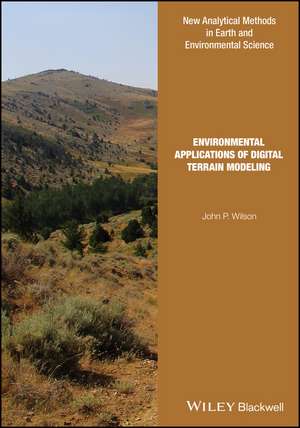Environmental Applications of Digital Terrain Modeling: Analytical Methods in Earth and Environmental Science
Autor JP Wilsonen Limba Engleză Hardback – 17 apr 2018
This book examines how the methods and data sources used to generate DEMs and calculate land surface parameters have changed over the past 25 years. The primary goal is to describe the state-of-the-art for a typical digital terrain modeling workflow that starts with data capture, continues with data preprocessing and DEM generation, and concludes with the calculation of one or more primary and secondary land surface parameters. Taken as a whole, this book covers the basic theory behind the methods, the instrumentation, analysis and interpretation that are embedded in the modern digital terrain modeling workflow, the strengths and weaknesses of the various methods that the terrain analyst must choose among, typical applications of the results emanating from these terrain modeling workflows, and future directions.
This book is intended for researchers and practitioners who wish to use DEMs, land surface parameters, land surface objects and landforms in environmental projects. The book will also be valuable as a reference text for environmental scientists who are specialists in related fields and wish to integrate these kinds of digital terrain workflows and outputs into their own specialized work environments.
Preț: 638.13 lei
Preț vechi: 944.80 lei
-32% Nou
Puncte Express: 957
Preț estimativ în valută:
122.12€ • 126.77$ • 101.83£
122.12€ • 126.77$ • 101.83£
Carte indisponibilă temporar
Doresc să fiu notificat când acest titlu va fi disponibil:
Se trimite...
Preluare comenzi: 021 569.72.76
Specificații
ISBN-13: 9781118936214
ISBN-10: 1118936213
Pagini: 360
Dimensiuni: 181 x 258 x 22 mm
Greutate: 0.95 kg
Editura: Wiley
Seria Analytical Methods in Earth and Environmental Science
Locul publicării:Chichester, United Kingdom
ISBN-10: 1118936213
Pagini: 360
Dimensiuni: 181 x 258 x 22 mm
Greutate: 0.95 kg
Editura: Wiley
Seria Analytical Methods in Earth and Environmental Science
Locul publicării:Chichester, United Kingdom
Public țintă
This book is intended for researchers and practitioners who wish to use DEMs, land surface parameters, land surface objects and landforms in environmental projects. The structure of the book will be such that it can be used as a text for a graduate level seminar, or as part of an advanced course on environmental analysis and modeling. The book will also be valuable as a reference text for environmental scientists who are specialists in related fields and wish to integrate these kinds of digital terrain workflows and outputs into their own specialized work environments.Notă biografică
Dr. John P. Wilson is Professor of Spatial Sciences in the Dana and David Dornsife College of Letters, Arts and Sciences at the University of Southern California (USC) where he directs the Spatial Sciences Institute as well as the Geographic Information Science & Technology (GIST) Graduate Programs and GIS Research Laboratory, and also holds adjunct appointments as Professor in the School of Architecture and in the Viterbi School of Engineering s Departments of Computer Science and Civil & Environmental Engineering.






